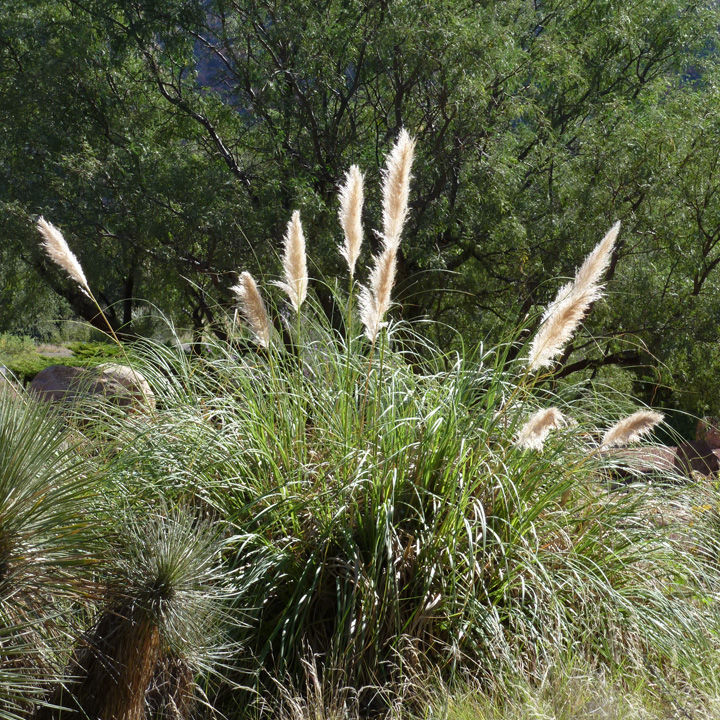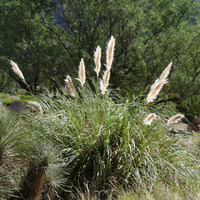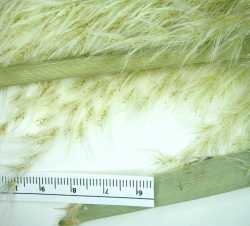Plants usually dioecious, sometimes monoecious. Culms 2-4 m, usually 2-4 times as long as the panicles. Leaves primarily basal; sheaths mostly glabrous, with a dense tuft of hairs at the collars; ligules 1-2 mm; blades to 2 m long, 3-8 cm wide, mostly flat, cauline, ascending, arching, bluish-green, abaxial surfaces glabrous basally. Panicles 30-130 cm, only slightly, if at all, elevated above the foliage, whitish or pinkish when young. Spikelets 15-17 mm; calluses to 1 mm, with hairs to 2 mm; lemmas long-attenuate to an awn, awns 2.5-5 mm; paleas to 4 mm; stigmas exserted. Caryopses and florets not separating easily from the rachilla. 2n = 72.
Cortaderia selloana is native to central South America. It is cultivated as an ornamental in the warmer parts of North America. It was thought that it would not become a weed problem because most plants sold as ornamentals are unisexual, but it is now considered an aggressive weed in California and Bendigo, Australia. The weedy Australian plants are bisexual (Walsh 1994).
Perennials, Terrestrial, not aquatic, Stems nodes swollen or brittle, Stems erect or ascending, Stems caespitose, tufted, or clustered, Stems terete, round in cross section, or polygonal, Stem internodes hollow, Stems with inflorescence 1-2 m tall, Stems with inflorescence 2-6 m tall, Stems with inflorescence 6 m or taller, Stems, culms, or scapes exceeding basal leaves, Leaves mostly basal, below middle of stem, Leaves conspicuously 2-ranked, distichous, Leaves sheathing at base, Leaf sheath mostly open, or loose, Leaf sheath smooth, glabrous, Leaf sheath hairy at summit, throat, or collar, Leaf sheath and blade differentiated, Leaf blades linear, Leaf blades 2 or more cm wide, Leaf blades mostly flat, Leaf blades mostly glabrous, Leaf blades glaucous, blue-green, or grey, or with white glands, Ligule present, Ligule a fringe of hairs, Inflorescence terminal, Inflorescence an open panicle, openly paniculate, branches spreading, Inflorescence a contracted panicle, narrowly paniculate, branches appressed or ascending, Inflorescence solitary, with 1 spike, fascicle, glomerule, head, or cluster per stem or culm, Inflorescence branches more than 10 to numerous, Flowers unisexual, Plants dioecious, Spikelets pedicellate, Spikelets laterally compressed, Spikelet less than 3 mm wide, Spikelets with 3-7 florets, Spikelets solitary at rachis nodes, Spikelets all alike and fertille, Spikelets unisexual, Spikelets disarticulating above the glumes, glumes persistent, Spikelets disarticulating beneath or between the florets, Spikelets conspicuously hairy , Rachilla or pedicel glabrous, Glumes present, empty bracts, Glumes 2 clearly present, Glumes distinctly unequal, Glumes equal to or longer than adjacent lemma, Glume equal to or longer than spikelet, Glumes 1 nerved, Lemma similar in texture to glumes, Lemma 3 nerved, Lemma body or surface hairy, Lemma apex acute or acuminate, Lemma awnless, Lemma margins thin, lying flat, Lemma straight, Callus or base of lemma evidently hairy, Callus hairs shorter than lemma, Lemma surface pilose, setose or bristly, Palea present, well developed, Palea membranous, hyaline, Palea shorter than lemma, Palea 2 nerved or 2 keeled, Palea keels winged, scabrous, or ciliate, Stamens 3, Styles 2-fid, deeply 2-branched, Stigmas 2, Fruit - caryopsis, Caryopsis ellipsoid, longitudinally grooved, hilum long-linear.
Common Name: Uruguayan pampas grass
Duration: Perennial
Nativity: Non-Native
Lifeform: Graminoid
General: Usually dioecious, but sometimes monoecious perennial, with stems 2-4 m, usually 2-4 times as long as the panicles.
Vegetative: Primarily basal leaves, sheaths mostly glabrous, with a dense tuft of hairs at the collars, blades to 2 m long, 3-8 cm wide, mostly flat, cauline, ascending to arching, bluish-green, lower surfaces glabrous basally.
Inflorescence: Panicles 30-130 cm, only slightly elevated above the foliage, whitish or pinkish when young; spikelets 15-17 mm, with calluses to 1 mm, with hairs to 2 mm, lemmas long-attenuate to an awn, awns 2.5-5 mm, paleas to 4 mm, stigmas exserted.
Ecology: Found in disturbed sites, often along roadways.
Notes: Native to South America, brought to the United States as an ornamental. Distinctive with its big arching blades, tall stems that end in white panicles.
Ethnobotany: Unknown
Etymology: Cortaderia is from cortadera, an Argentinian Spanish word for cutting, while selloana is named for Friedrich Sellow (1789-1831) a German plant collector who collected extensively in South America.
Synonyms: Cortaderia dioica
Editor: SBuckley, 2010














